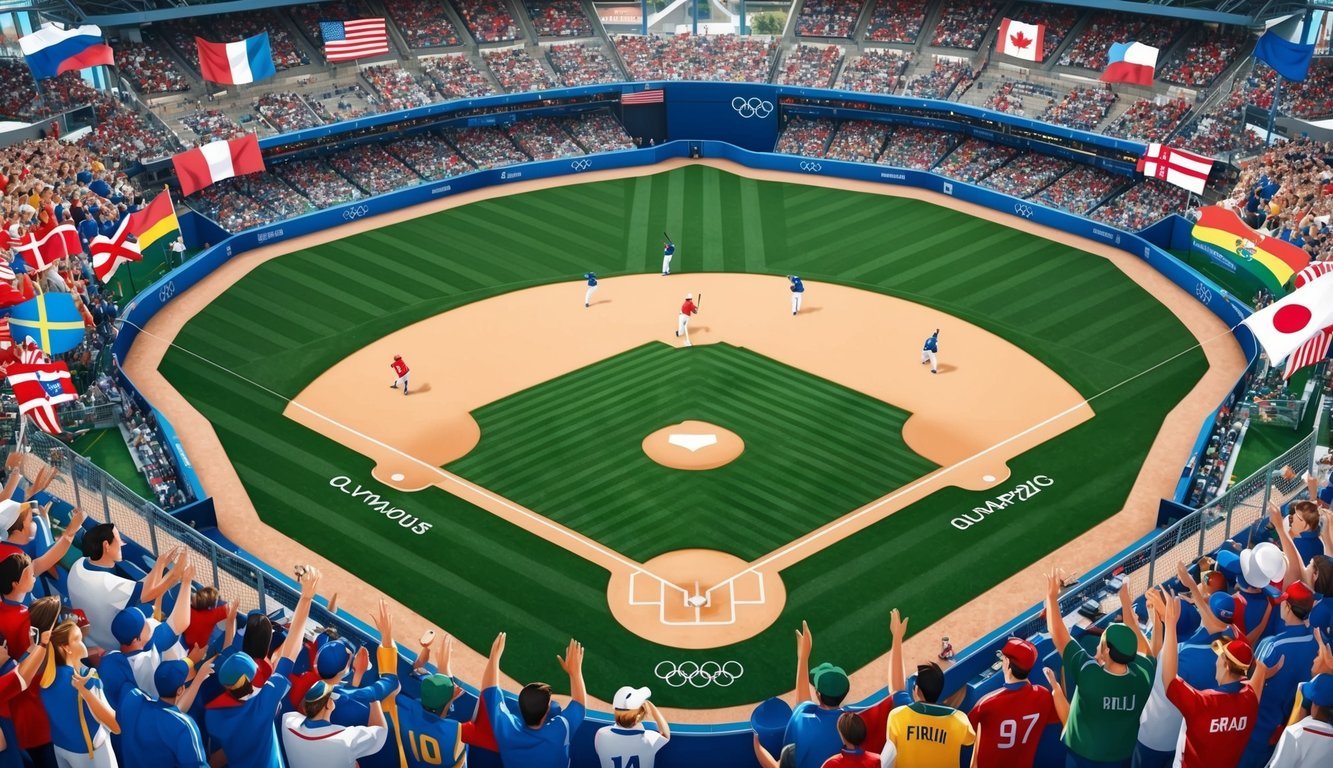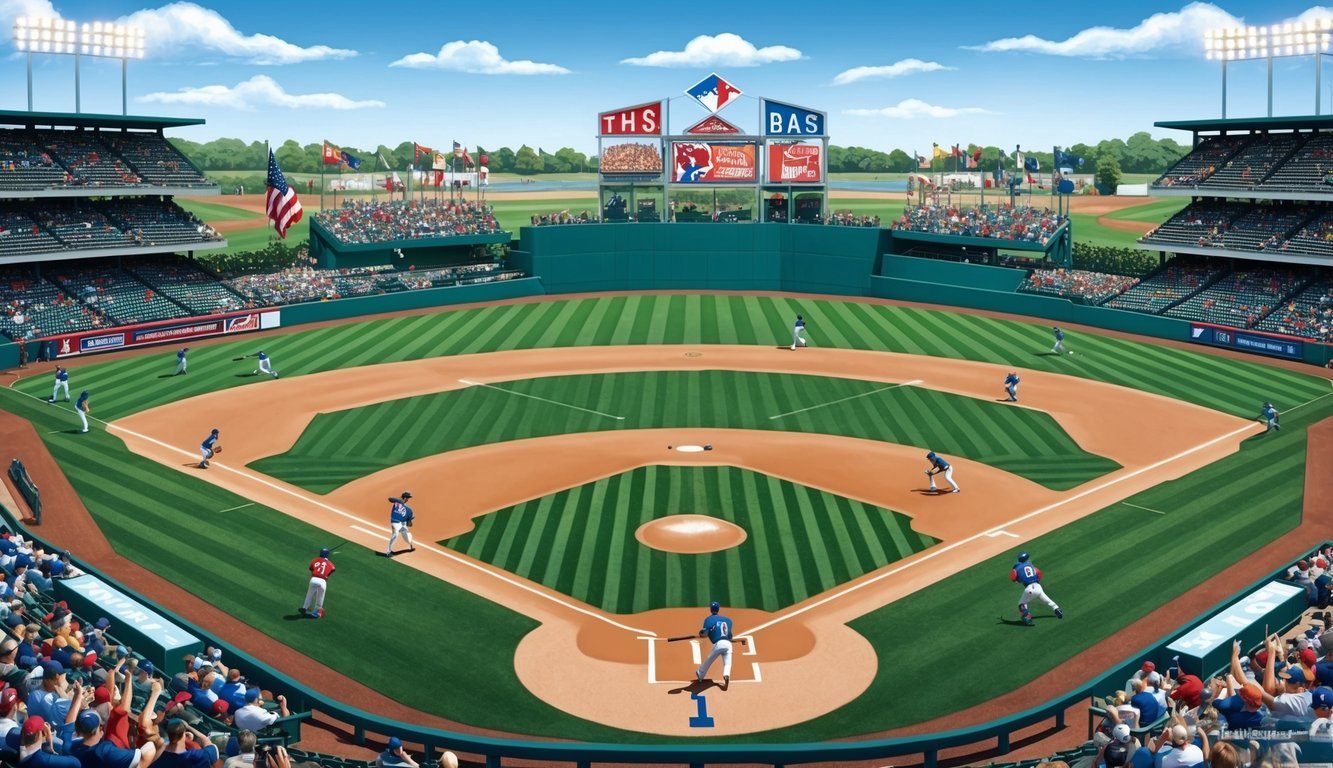Baseball has been part of the Olympic Games since its formal introduction as a medal event at Barcelona 1992.
The sport’s Olympic journey began much earlier, with exhibition games dating back to the 1900 Paris Games.
The most recent Olympic baseball tournament took place at the Tokyo 2020 Games, marking the sport’s return after a 12-year absence.
Six teams qualified for the event, including host nation Japan, the United States, South Korea, Israel, Mexico, and the Dominican Republic.
The tournament used a unique format combining round-robin group play with knockout rounds to determine the medal winners.
Olympic baseball tournaments feature intense competition among the world’s top national teams, showcasing the highest level of international play outside of professional leagues.
The most recent Olympic baseball tournament took place at the Tokyo 2020 Games, marking the sport’s return after a 12-year absence.
Six teams qualified for the event, including host nation Japan, the United States, South Korea, Israel, Mexico, and the Dominican Republic.
The tournament used a unique format combining round-robin group play with knockout rounds to determine the medal winners.
Olympic baseball provides a thrilling showcase for both established stars and rising talents.
While Major League Baseball (MLB) players are typically unavailable due to conflicts with the regular season, the Olympic stage offers a platform for players from various professional leagues and top amateur prospects to represent their countries.
This mix of talent creates exciting matchups and often leads to surprising results on the diamond.
Origins and Evolution of Olympic Baseball

Baseball’s journey in the Olympic Games spans over a century, transitioning from an exhibition sport to a full medal event.
The sport’s Olympic history reflects its growing global popularity and significance on the world stage.
A Historical Perspective
Baseball’s Olympic debut occurred at the 1900 Paris Games, though details of this early appearance are scarce.
In 1912, Stockholm hosted a game between the United States and Sweden, with the Americans winning 13-3.
The sport made sporadic appearances in subsequent Olympics, including Berlin 1936 and Melbourne 1956.
During the 1956 Games, Australia and the United States played a full exhibition match, showcasing baseball’s international appeal.
This event marked a significant step in Olympic baseball history, as it featured two complete teams from different nations competing against each other.
Olympic Baseball as an Exhibition Sport
Baseball’s status as an Olympic exhibition sport solidified in the latter half of the 20th century.
The 1984 Los Angeles Olympics and 1988 Seoul Games both included baseball as a demonstration event, generating increased interest and participation.
In Seoul 1988, eight teams competed in the baseball tournament, setting the stage for the sport’s eventual inclusion as a medal event.
The success of these exhibition appearances paved the way for baseball to join the official Olympic program at the 1992 Barcelona Games.
Since then, baseball has featured in several Olympics, including Beijing 2008.
After a brief hiatus, the sport made a triumphant return at the Tokyo 2020 Games, reigniting passion for Olympic baseball among fans worldwide.
The Olympic Baseball Tournament Format

Olympic baseball features a unique competition structure with limited team slots.
The tournament combines round-robin play and knockout rounds to determine medalists.
Qualification and Team Selection
Six national teams qualify for Olympic baseball.
This makes it one of the most exclusive events at the Games.
Countries earn spots through regional tournaments and a final qualifying event.
Top baseball nations like Japan, South Korea, and the United States often participate.
The host country typically receives an automatic berth.
Other teams must battle through a rigorous qualification process to secure their Olympic spots.
This ensures only the world’s elite baseball squads compete for medals.
Competition Format and Rules
The Olympic baseball tournament uses a hybrid format.
It starts with two groups of three teams each playing round-robin games.
All six teams then advance to the knockout stage, regardless of their group results.
The knockout round follows a double-elimination format.
This gives teams a second chance after a loss.
The tournament culminates in the gold medal game between the top two remaining teams.
Olympic baseball has some unique rules:
- Games may end early due to the mercy rule
- Extra innings start with runners on base
- Tie-breakers determine standings in group play
This format creates exciting, high-stakes baseball as teams vie for Olympic glory.
Iconic Olympic Baseball Venues

Olympic baseball has graced some of the most impressive stadiums in the world.
These venues blend modern amenities with rich baseball heritage, creating unforgettable experiences for players and fans alike.
The atmosphere in these stadiums is electrifying, often filled with passionate fans cheering for their countries.
Players showcase their skills in a setting that highlights the beauty of the sport, while footnotes of history remind everyone of its deep-rooted tradition.
As athletes don their gear, discussions often arise about the differences between baseball cleats vs football cleats, showcasing how each sport requires specific footwear to maximize performance on the field.
Yokohama Stadium
Yokohama Stadium stands as a crown jewel among Olympic baseball venues.
Located in the bustling port city of Yokohama, this 34,000-seat stadium has hosted thrilling international competitions.
Built in 1978, it’s the regular home of the Yokohama DeNA BayStars of Nippon Professional Baseball.
The stadium’s unique open-air design offers breathtaking views of Yokohama’s skyline.
During the Olympics, Yokohama Stadium buzzes with energy.
Its state-of-the-art facilities and excellent sightlines make it a favorite among players and spectators.
The venue’s proximity to Tokyo adds to its appeal, making it easily accessible for Olympic visitors.
Fukushima Azuma Baseball Stadium
Fukushima Azuma Baseball Stadium holds a special place in Olympic baseball history.
Located in Fukushima Prefecture, this venue symbolizes resilience and hope.
The stadium underwent significant renovations to host Olympic games.
Its 30,000 seats welcome fans to enjoy world-class baseball in a picturesque setting.
Fukushima Azuma has become a symbol of recovery for the region.
Hosting Olympic baseball here highlights the area’s progress since the 2011 disaster.
The stadium’s modern amenities and warm atmosphere create memorable experiences for all who visit.
Prominent Teams and Players in Olympic Baseball

Olympic baseball has showcased exceptional talent and thrilling competitions over the years.
Several nations have fielded strong teams, while individual players have left lasting impressions on the international stage.
Memorable Teams
Cuba dominated Olympic baseball for years, winning gold medals in 1992, 1996, and 2004.
The United States claimed victory in 2000, led by future MLB stars like Ben Sheets and Doug Mientkiewicz.
South Korea emerged as a powerhouse, securing gold in 2008 with a perfect 9-0 record.
Japan, a baseball-loving nation, has consistently fielded competitive teams.
Their silver medal performance in 1996 and bronze in 2004 highlighted their prowess.
The Dominican Republic, known for producing MLB talent, made its Olympic debut in 2020, adding excitement to the tournament.
Legendary Olympic Baseball Players
Numerous players have shined in Olympic competition.
Cuban pitcher Pedro Luis Lazo, a four-time Olympian, earned two gold medals and two silvers.
He was nearly unhittable in international play.
Hyun-jin Ryu, who later starred for the Los Angeles Dodgers, helped South Korea win gold in 2008.
His dominant performances caught the attention of MLB scouts.
Stephen Strasburg, before becoming an MLB ace, dazzled for Team USA in 2008.
He struck out 11 batters in his Olympic debut, showcasing his future potential.
Shohei Ohtani, Japan’s two-way sensation, participated in the 2020 Tokyo Olympics before his MLB stardom.
His versatility and skill exemplified the high caliber of Olympic baseball competition.
The Future of Olympic Baseball

Olympic baseball’s prospects are evolving rapidly.
Key developments include potential program changes and emerging teams shaping the sport’s global appeal.
Looking Towards Paris 2024 and Beyond
Baseball won’t feature in the Paris 2024 Summer Olympics.
This absence has sparked discussions about its future inclusion.
The sport’s governing body, the World Baseball Softball Confederation, is working to address concerns.
They’re exploring ways to enhance the competitive quality of Olympic tournaments.
One idea is allowing more professional players to participate.
This could boost viewer interest and showcase top talent.
Another focus is improving baseball infrastructure in more countries.
This effort aims to broaden the sport’s global reach and competitiveness.
Inclusion in the Olympic Program
Baseball’s Olympic future remains uncertain.
The sport faces challenges in securing a permanent spot in the Summer Games.
One hurdle is the limited global popularity compared to other Olympic sports.
Baseball’s strongholds are in the Americas and parts of Asia.
The Olympic program’s emphasis on gender equality also impacts baseball’s chances.
Including both baseball and softball could help address this concern.
Efforts are underway to make Olympic baseball more appealing.
Proposed changes include shorter game formats and innovative rules to speed up play.
These adaptations could make baseball more TV-friendly and increase its chances of Olympic inclusion beyond 2028.
